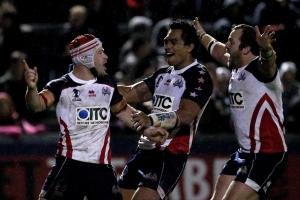In America more often than not you are a fan of either Football or Hockey or Basketball. Now this is not to say that there are not a lot of people who enjoy all three, however there tends to be common consent that you like either one or the other. In rugby terms in the Northern Hemisphere you EITHER like Union OR League, and that is that! The numbers of people who like both equally are miniscule.
And here lies the problem, because whilst the U.S Eagles and their Sevens counterparts seem to be stuck in a rut of maximum effort and minimal success, (yes I know you beat Georgia and Russia, but is that an improvement or should that be considered a normal result bearing in mind the professionals the Eagles can now call on? And let’s not get started on the Sevens). The U.S Tomahawks showed that with a handful of virtual no names and THREE recognized rugby league players, they could go deep into the world showcase event of rugby league. More to the point was the guts and determination the Tomahawks showed. Some will argue it was a Cinderella story that will only happen once in a generation, but the fact remains that a bunch of rank amateurs accompanied by three professionals (Eddy Pettybourne, Joseph Paulo and Clint Newton) beat the sixth best team in the world (Wales) comprehensively. They beat a powerful Cook Islands line up, and led a useful Scottish outfit. In doing so they inspired the Rugby League world, songs were written (check out the Wiggles on YouTube) and several amateur players were offered chance at high profile NRL and Super League clubs (Taylor Welch at Hull F.C and Bureta Faraimo at Parramatta)

The question now is whether the United States will kick on from this RLWC success and build the sport within the U.S.A. In truth the various rugby league associations in America (AMNRL and USARL) do not have anywhere near the organization of U.S.A Rugby, writing this article was a nightmare based on what can be found on the internet about the various governing bodies of the sport within America, however that is not the point. The point is that all it requires is for a hard core East Coast base of clubs (with the exception of Hawaii and Utah, the game is concentrated on the Eastern side of the United States) to divert a small percentage of the rugby union playing population on that side of the country to league for there to be a serious split within the rugby playing ranks of America.
Whilst rugby is the fastest growing team sport in the U.S, make no mistake it is still tiny in terms of playing population, viewing figures and professionalism. To lose a portion of the rugby union playing population to rugby league would do massive damage to a sport that is still trying to find an identity and a voice within the cash fuelled machine that is the American sporting world.
Now, since I know the critics are winding up to tear this argument apart, make no mistake I want both sports to succeed, as a coach, player and commentator I think that both league and union are equally as important in the formation of players, regardless of which code they choose to use these skills. And it is just about possible, if we assume that league and union take place at different times of the year. For instance in New York the AMNRL happens during the Sevens season as opposed to in the middle of the 15s season. This means that players who feel they are specifically Sevens players can play Sevens whilst 15s players who want to play league both for enjoyment and skills improvement (or indeed vice versa with league players to union) can do so.
With both sports still in almost foetal levels of development in comparison to their competitors it is fundamental that they take a Southern Hemisphere (more specifically a New Zealand) based approach to league and union. In New Zealand from day one kids grow up playing both codes. Yes they have to make a decision at some point and as the two codes develop in the U.S this choice will have to be made. But it is a choice that these youngsters make organically depending on which code identifies their talent and sees a player they like. Neither code is attacked or chided for being the weaker of the two, instead there is a healthy respect between the players of both that they each bring something different to a person’s game.

With such a short history of rugby within the United States it is absolutely crucial that the codes are allowed to develop without enmity or feuding between the two. If this infighting happens (as is the case in Great Britain) then it is safe to say there willbe a developmental power grab over who can colonize and consolidate their fan bases whilst expanding their own game as fast as possible within the U.S. The only way for this to work is for the two codes to take place at different times of the year, allowing players to switch from one to the other (such as Luke Hume) without overlap. If this can be achieved then players within the U.S will hopefully develop a healthy enjoyment for both sports and much like the Australian and New Zealand league and union teams, perhaps there will be a knock on learning effect for both codes at the highest international level.

